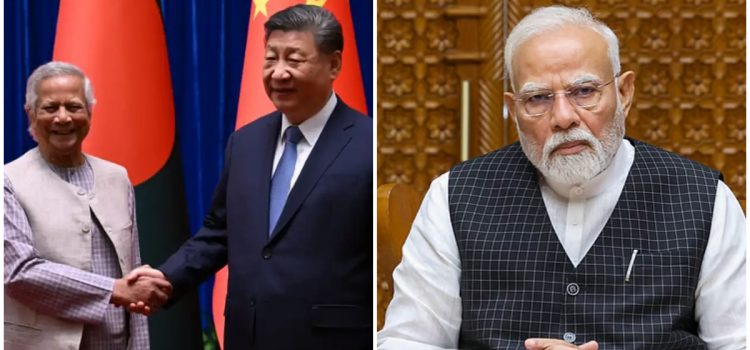
During her 15 years in power, Sheikh Hasina had gradually built a close relationship between Bangladesh and India. Under Hasina, the country’s economy grew faster, and ties with India became stronger in trade, energy, and defense. But since her exit, Bangladesh now seems to be moving closer to China. Earlier, many experts had believed that her departure could shake up the region’s politics and possibly change the balance of power in South Asia. And this is quite visible with Bangladesh’s growing closeness with China.
A key moment of this renewed relationship was seen during the recent visit of Bangladesh’s Chief Adviser Muhammad Yunus to Beijing. The visit marked 50 years of diplomatic relations between the two countries. Since they officially established ties in 1975, China has played a major role in Bangladesh’s development and is now its biggest partner in both trade and defense.
Hasina, Bangladesh’s longest-serving prime minister, was seen as a reliable and secular leader in a Muslim-majority country of 170 million people. She cracked down on anti-India insurgent groups, took strong action against rising Islamic extremism, and kept the military in check in a country known for past army takeovers. These moves made her a valuable partner for India, especially as tensions rose with China and long-time rival Pakistan. Her departure has now created uncertainty, as the next government seems to be more open to working with China, a move that could challenge India’s influence in the region.
Hasina also helped India maintain stability in a region where other South Asian countries, like Nepal and the Maldives, have over a period of time, leaned closer to China. China’s influence remains strong in Sri Lanka too.
Bangladesh is growing closer to China and India isn’t happy
Analysts at the global consultancy firm Teneo had told Reuters last year that China could become a major source of financial support for Bangladesh, especially as the country was facing growing economic problems. They also said that if Sheikh Hasina left office, Bangladesh might move closer to China.
That prediction now seems to be coming true. After Hasina’s exit, Bangladesh has begun leaning more towards China, attracted by the promise of more trade, investment, and cheaper weapons. But this shift is causing problems in its relationship not just with India, but also with the United States. America is the biggest buyer of Bangladeshi goods and was one of its top aid donors until the Trump-era cuts.
India is also evidently unhappy because its relationship with Bangladesh had been improving until mid-2024, but things then started to go downhill. In recent months, India has cancelled a trans-shipment deal that had been helping Bangladeshi companies, and it has also deported Bangladeshi migrants. Now, India is looking to renegotiate a key treaty on sharing river water between the two countries.
China-Pak-Bangladesh: A trilateral force taking shape
Bangladesh, Pakistan and China had recently met in Kunming to discuss forming a new regional group that would replace SAARC – South Asian Association for Regional Cooperation. Although Bangladeshi officials insist it wasn’t a political move, the timing and participants suggest otherwise. The meeting closely followed a separate China-Pakistan-Afghanistan discussion in May, where they talked about expanding the China-Pakistan Economic Corridor. Analysts worry that this new bloc could become a South Asian arm of China’s Belt and Road Initiative.
India was clearly sidelined. While the new group may formally invite Delhi, reports suggest India is unlikely to join due to clashing interests. SAARC has remained inactive since 2016, when India and others boycotted a summit in Pakistan after the Uri terror attack. Now, as Pakistan and China push a new regional plan with Bangladesh’s support, India risks losing influence in its own neighborhood.










